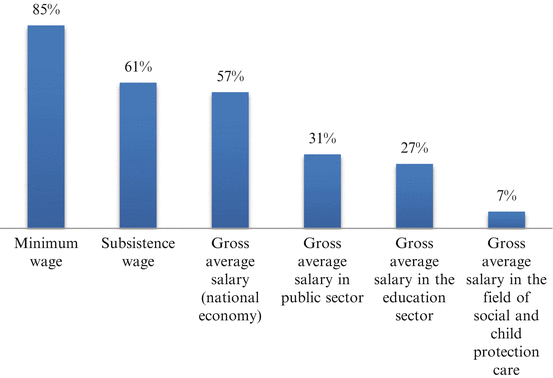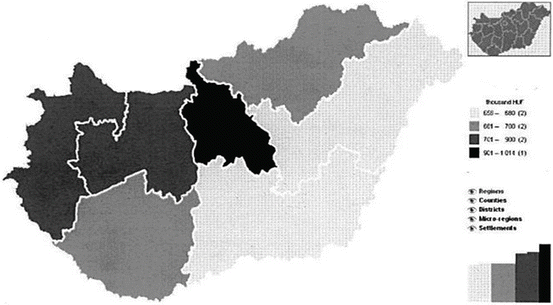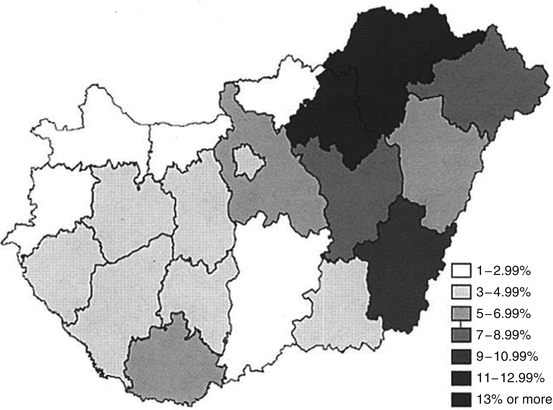Poor Children, Poor Services, Poor Outcomes: Child Poverty and Its Impact on Referral and Placement in Public Care System in Hungary

Fig. 15.1
Children at risk of poverty or social exclusion – AROPE (Percentage of all children), 2011 (Eurostat SILC 2013)
The last two decades have seen a shift in risks of poverty and social exclusion from the elderly to younger generations and children, especially the most vulnerable children and young persons. There is a wide gap in performance of the welfare systems of the EU countries – the best reduced the risk of poverty by 35 %, the least effective by less than 15 % (EU average 35 %) (DG Employment and Social Affairs and Inclusion 2014).
The economic crisis and the austerity measures have affected the different countries of the EU in very diverse ways. Officially, by 2010 most European countries moved out of recession, but there are many signs of an on-going and long lasting crisis. These include large cuts in public spending in health, education and the social services, tightening of eligibility criteria and reduction of provisions and access in many countries. Rising housing and energy costs and debts of the population, especially in the new member states, are causing tension. Changing employment patterns primarily affect poorer and less educated groups, now accompanied by reduction of social support as well. Discrimination of women, disabled persons and minorities (in Hungary the Roma) has not been reduced and the financial crisis has deepened the problem. Reductions of public expenditure have resulted in more unpaid work, with a greater burden on family members (Oxfam International and European Women’s Lobby 2010).
Thus, while the need for intervention is increasing, key services and policies supporting children and families are being affected by budget cuts, tighter eligibility criteria, and cut or freezes in level of benefits. Even while considering budget consolidation, we must find ways to keep investing in Europe’s children and give them the best possible start in life (Andor 2012).
15.2 Poverty in Hungary
In 2011 the population of Hungary was almost ten million,2 20.6 % of the population was under 18 years of age. Life expectancy for men at birth was 70.93 and for women 78.23 (HCSO 2011). In 2012, 17 % of the Hungarian population was poor due to low income, 19 % were poor due to the lack of any type of employment by any member of the family, 37 % were living in severe material deprivation. Forty-seven percent of Hungarian families were living in a household, where at least one form of social exclusion (of women, disabled people and minorities), and poverty was present and 8 % where all three instances of exclusion of were present. This covers half the population, five million people, of whom one million were living in deepest poverty, lacking running water, toilet, basic facilities and, often, electricity. In 2011, 15–20 % of children were living in a household where no-one worked. Due to the reductions of allowances and financial and in-kind aid provided to the poor there has been a sharp increase of poverty and deep poverty. The proportion of child poverty has risen by 50 % in 4 years, between 2010 and 2014 (Ferge and Darvas 2012). In 2013 Hungary was the fifth worst of the 27 EU member states. It showed the fourth highest risk of poverty and social exclusion among those experiencing severe material deprivation, particularly among children, young people and women (Europe 2020 Targets, Fig. 15.1).
Poverty in the more developed part of Europe is more an urban phenomenon, but in Hungary poverty is more characteristic in the villages. The significant regional differences in poverty levels are related to very limited access to employment, transportation and services in many small, isolated settlements, as shown on the map on gross income and tax (Fig. 15.2). Approximately 100 settlements are almost purely Roma and in a further 200 the proportion of Roma in the settlement is increasing as others move to more developed areas of the country (Fig. 15.3). Together these form almost 10 % of settlements in Hungary. Two third of the 15 million Roma in Europe are unemployed due to the lack of proper education, qualification and discrimination. Almost half the population are younger than 18 years of age, 50 % of the children attend only kindergarten and only 15 % complete secondary education (Report on the implementation of the EU framework for the Roma National Integration Strategies 2014). In Hungary in 2011 25 % of the Roma population between 15 and 64 was employed, this ratio for Roma women was 13–16 % with a high proportion of casual or informal work in the grey or black economy (Open Society Foundations and Decade of Roma Inclusion 2013). The distribution of the Roma population and settlements are shown on Fig. 15.3 demonstrates the concentration of the Roma at the most deprived, poorest regions, areas of Hungary.



Fig. 15.2
Hungary: gross income serving as the basis of personal income tax of permanent population (HCSO 2013a)

Fig. 15.3
Proportion of Roma population compared to the constant population by counties, 2003 (Kemeny et al. 2004)
The lack of belonging, isolation, segregation and discrimination faced by poor children increases the risk of leaving school early, of committing offenses or becoming a victim of crime or both, of teenage pregnancy and of substance abuse (Bäckman and Nilsson 2011). Reducing childhood and intergenerational deprivation and poverty requires high quality, accessible and preferably free services for all children in need, that can be targeted and specialized as required.
For decades Hungary has provided a generous and well-developed set of universal services. “The communist system led to a ‘premature welfare state’, with universal entitlements out of all proportion to the country’s resources and the fiscal capacity of the state. Many citizens suffer heavy losses when the proportions are restored” (Kornai 1997). For instance, the 3 years paid maternity allowance established in 1967 is a unique opportunity that no political party or government has dared to touch, despite its controversial nature (Blasko 2009).
For decades there has been an understanding that education, health care and all type of available social services would be universal and free. The more recent recognition of the costs, the tax-based contribution, privatization and paid services, and selectivity of eligibility have caused severe disappointment, especially as there has been no discussion nor transparent political articulation of the problems and the possible solutions. As in other countries, the increasingly strong and growing negative sentiments against the poor, disadvantaged and those with special needs has led to the growing popularity of populism and extremist, radical approaches (The Extreme Right in Contemporary Europe 2009).
15.3 Child Welfare, Child Protection
Despite the steadily declining birth rate and decades of efforts to encourage births, there has been only very little acknowledgement of the reasons for the low fertility rate and little support for families struggling to provide a good enough upbringing for their children (Giczi 2010). There are wide ranges of universal services (health visitation, pediatric GPs, early childhood education and care services, free primary and secondary education, child welfare services) but their allocation does not match the needs of the poor areas with the greatest child populations.
Services like after- or out of school care, counselling, prevention and early intervention, mental health services, help for victims of abuse and substance abusers are very limited and especially not available for the poorest, most deprived, isolated communities, families, children.
Abandonment is a further problem. In Western Europe children are mainly abandoned due to mental illness, other psychological reasons or substance abuse. In Central and Eastern Europe many children are abandoned due to poverty and lack of access to services, lack of social support, lack of contraception or access to abortion. In Hungary poverty causes 75 % of abandonments, followed by poverty-related homelessness and single or teenage parenthood (University of Nottingham 2012).
In Hungary there are over 5,000 highly skilled health visitors, almost 80 % of them working as home visitors, the rest in schools and as youth community nurses. Their 4 years of college training prepare them for a very demanding and complex profession. They are providing universal services to children, pregnant women and mothers. They are also dealing with counselling on contraception, pre-natal care, home visits and parenting support; their job description covers more than possible to fulfill (ESzCsM Regulation 2014).
Mostly children under 7 years of age are visited. The visitation of newborns after release from hospital has decreased sharply, preventing early detection of at-risk families and children. Pre-natal home visits could serve as a prevention opportunity but health visitors mostly only warn child welfare services if they consider that an immediate out-of-home placement for the newborn is required (Draft of the Government Decree 2009).
Nationally a further 5.8 % of health visitors are required but in the poorest area an average of 7.9 %, sometimes even 15 % are lacking. Each health visitor must take care of 250 children, and due to the distances between settlements and poor transportation opportunities, the poorest children and families, those most in need, are often not visited or not supported properly. A health visitor complained to the Ombudsman that she had to take care of over 600 children instead of the 250, which could not be done (Report of the Ombudsman 2010). Investigations by the Ombudsman revealed that two cases of child death from starvation were partly due to insufficient visits, interventions and referrals. The responsibility of family doctors and social workers, as well as of the health visitors, was documented (Report of the Ombudsman 2008).
Almost 3,000 social workers provide services all over the country, but their caseload numbers are extremely high, without proper specialized services to which the family members can be referred. According to the data almost one-third of the problems are related directly to poverty or financial needs, while others need specialized support. Social workers in child welfare services can provide such support only in a limited number of cases, due to the lack of skills, knowledge and caseload capacity (Table 15.1).
Type of problem | 2000 | 2012 |
|---|---|---|
Financial | 102,370 | 180,081 |
Child rearing | 60,775 | 158,692 |
Integration difficulties | 16,603 | 57,556 |
Disorder of behavior | 32,764 | 94,348 |
Family conflict | 40,895 | 68,256 |
Life management issues | 51,093 | 111,800 |
Neglect by parents | 21,954 | 50,285 |
Abuse within the family | 4,857 | 13,802 |
Disability | 8,972 | 8,989 |
Addiction, substance use | 15,258 | 12,583 |
Total | 355,541 | 756,392 |
In 2000 51.2 % of settlements provided family support services only. By 2011 this had risen to 93.2 %, although the number of provisions locally declined from 39.5 to 22 % due to centralization (Tables 15.2 and 15.3, Fig. 15.4). Centralization has led to decreasing access to services locally. It has also increased the workload, with less time spent with clients, and more travel time for those working in family help centres in the sub-regions, or limiting the access of the services for clients who cannot afford transportation to the centres. As shown in Table 15.3 the small settlements lost their local services based on the financial rationalization and budget cuts.
Table 15.2
Data on child welfare services by region and county, 2012 (HCSO 2013a)
Region, county | Number of | Number of | Ratio of | Number of children receiving service | Number of families receiving service | ||
|---|---|---|---|---|---|---|---|
Child welfare services | Settlements running child welfare service | Settlements covered by service | Settlements supplied by child welfare service, % | ||||
Central Hungary | 98 | 71 | 119 | 187 | 99.5 | 34,587 | 21,684 |
Transdanubia | 137 | 130 | 1,023 | 1,145 | 98.7 | 36,520 | 20,688 |
Great Plain and North | 403 | 393 | 871 | 1,252 | 100.0 | 74,217 | 39,942 |
Country, total | 686 | 639 | 2,514 | 3,128 | 99.2 | 145,324 | 82,314 |
Table 15.3
Settlements with local unit of family support services in proportion of settlements providing services (HCSO 2012a)
Population | Proportion (%) |
|---|---|
0–499 | 2.7 |
500–999 | 7.4 |
1,000–1,999 | 20.4 |
2,000–4,999 | 47.2 |
5,000–9,999 | 87.9 |
10,000–19,999 | 94.2 |
20,000–49,999 | 97.5 |
50,000–99,999 | 100.0 |
100,000–x | 100.0 |
Budapest (capital city) | 100.0 |